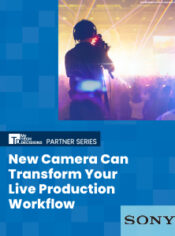Reinforcing its resume, which already includes placement on the Rock-and-Roll Hall of Fame, giants of the metal music genre Metallica released its 10th-studio album Hardwired to Self Destruct a little less than a year ago.
The album, which is now certified platinum, was supported in 2017 by the band’s “Hardwired Live” tour and will be featured throughout their fall tour dates in Europe.
Explaining how Metallica members James Hetfield, lead vocals, guitars, Lars Urich, drums, Robert Trujillo, bass, backing vocals, and Kirk Hammett, lead guita maintain their high standards of live sound are Hetfield and Hammett’s Metallica guitar techs Chad Zaemisch and Justin Crew.
In a video posted by “Metallica TV” Zaemisch and Crew go into great detail on the measures they take to eliminate issues, including wireless signal integrity and the challenges of producing a consistent signal flow for the band’s legendary front of house (FOH) engineer “Big” Mick Hughes.
Metallica Guitar Techs Use Shure & RF Antenna to Eliminate Wireless Interference
Zaemisch, who is Hetfield’s guitar tech, points out the band is touring with a large stage with a massive video screen and complicated lighting.
Elaborating on his and his crew’s specific setup, Zaemisch says they use a combination of Shure and RF Venue Antenna components to best ensure the audio fidelity of Hetfield, Trujillo and Hammett’s wireless signals. This allows them to roam freely on stage in front of a large video screen — one which emits high levels of interference.
“[We’re] trying to make everything look nice. With all the white [the stage is colored white], we couldn’t have a whole antenna farm out there. So we decided to put these in the best spot we could—a little trial and error—and we are sharing those with James’ [Hetfield] wireless, Robert’s [Trujillo, bass, Metallica] and Kirk’s [Hammett, lead guitar, Metallica] wireless, and we take a split all from there,” explains Zaemisch.
“We come back to the rack, we go into the Shure units, from there, we go into the RJM line mixer, the mini line mixer, which you should check out, for a little small unit has a ton of ins and outs, and we use that to sum the outputs of our wireless. Basically, we use two channels on each player. So we are flip flopping between the first channel and second channels when we are doing guitar changes when we have time to figure that out.”
From there, signals are routed into a Voodoo Labs GCX guitar audio switcher to ensure signal integrity, and through the use of separate signal loops, the signals are sent to separate Fractal Audio Axe-FxII XL+ guitar preamplifiers/processors.
The Fractal processors are programmed to emulate Hetfield’s favorite Mesa Boogie and Diezel amplifier distortion tones, as well has his favorite Fender “clean” tones for songs like Turn the Page and the intro to One, and signals from the processors are sent to front of house [FOH] where Hughes can monitor and record from his location in the mix tent.
Like many guitar players today that use “modeling amps” like the Fractal product, Zaemisch sends another signal to a Mesa Boogie 4×12 cabinet on stage that’s powered bya Matrix amplifier that allows Hetfield to “feel” the music and the concert’s audio fidelity.
Zaemisch also points out that a key element of Metallica’s sound involves how he switches between Hetfield’s clean and dirty guitar tones.
Due to the structure of the band’s songs, Zaemisch says that he switches between clean tones and distorted tones — “analog” style — to eliminate any switching gaps between tones because songs like One transition from clean to dirty with no breaks.
Rounding out Hetfield’s live setup is a Furman power conditioner, an array of ESP and Gibson guitars, a Peterson tuning app and a MIDI setup that supports the acoustic sounds in Fade to Black.
More from Metallica Guitar Techs on the Band’s Audio Fidelity
Moving to the other side of of the stage, Metallica guitar techs say that Hammett’s live rig is similar to Hetfield’s live setup.
Crew says Hammett uses a mix of ESP, LTD (a lower cost line from ESP), as well as a Gibson Flying V and a 1959 Gibson Les Paul Standard that was once owned by Gary Moore and Peter Green of Fleetwood Mac, and an early Jackson Randy Rhoads guitar that is tuned to “D” for Sad but True.
Hammett, who is known for his use of wah pedals, also employs five of these effects positioned strategically around the stage.
Explaining the wah setup in greater detail, Crew notes that Hammett employs the rack-mount versions of the famous guitar effect that are connected to the expression pedals on stage, and like Hetfield, his rack also contains the Voodoo Lab GCX, multiple Fractal preamp/processors for clean and dirty tones, and a Matrix amplifier that drives an on-stage cabinet.
Not to be forgotten with all of the technicality of Hetfield, Crew points out that Trujillo and Hammett’s rigs support consistent audio fidelity no matter the weather conditions or the venue.
“Here we have the same thing everyday, and it allows for Big Mick [Hughes, FOH, Metallica] who is dealing with a whole new environment everyday, to set their controls flat,” emphasizes Crew.
“We set it all up with Mike Gillies [recording engineer, Metallica] so they can pretty much set it up flat, pan left and right, 0dB and the guitars are coming in to them … it allows them to pretty much focus on the vocals.”
If you enjoyed this article and want to receive more valuable industry content like this, click here to sign up for our digital newsletters!












Thanks for sharing this. I’m currently working on the f# minor nocturne! they’re beautiful pieces. Afte completion of this, I would go for guitar lessons.
Don’t get me wrong, you have to be strong and confident to be successful in just about anything you do – but with music, there’s a deeper emotional component to your failures and successes. If you fail a chemistry test, it’s because you either didn’t study enough, or just aren’t that good at chemistry (the latter of which is totally understandable). But if you fail at music, it can say something about your character. It could be because you didn’t practice enough – but, more terrifyingly, it could be because you aren’t resilient enough. Mastering chemistry requires diligence and smarts, but mastering a piano piece requires diligence and smarts, plus creativity, plus the immense capacity to both overcome emotional hurdles, and, simultaneously, to use that emotional component to bring the music alive.
Before I started taking piano, I had always imagined the Conservatory students to have it so good – I mean, for their homework, they get to play guitar, or jam on their saxophone, or sing songs! What fun! Compared to sitting in lab for four hours studying the optical properties of minerals, or discussing Lucretian theories of democracy and politics, I would play piano any day.
But after almost three years of piano at Orpheus Academy, I understand just how naïve this is. Playing music for credit is not “easy” or “fun” or “magical” or “lucky.” Mostly, it’s really freakin’ hard. It requires you to pick apart your piece, play every little segment over and over, dissect it, tinker with it, cry over it, feel completely lame about it, then get over yourself and start practicing again. You have to be precise and diligent, creative and robotic. And then – after all of this – you have to re-discover the emotional beauty in the piece, and use it in your performance.